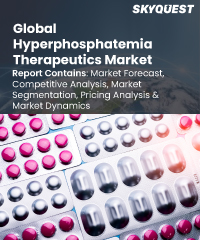
Report ID: SQSG35I2014

Report ID:
SQSG35I2014 |
Region:
Global |
Published Date: April, 2024
Pages:
157
|
Tables:
66 |
Figures:
75
Hyperphosphatemia Therapeutics Market size was valued at USD 3.3 Billion in 2023 and is poised to grow from USD 3.51 Billion in 2024 to USD 4.47 Billion by 2032, growing at a CAGR of 6.5% during the forecast period (2025-2032).
Hyperphosphatemia occurs when the blood contains an excessive amount of phosphate. This condition occurs in almost 90% of end-stage renal disease patients going through dialysis. Hyperphosphatemia therapeutics such as phosphate binders are used to reduce the gastrointestinal absorption of phosphorus. The most commonly prescribed phosphate binders are calcium salts, but these may produce hypercalcemia. Similarly, there are several phosphate binder drug classes used such as sevelamer, lanthanum carbonate, magnesium-based phosphate binders, and iron-based phosphate binders. The population with chronic kidney disease and cardiovascular disorders tends to have an abnormally high level of phosphate. Hyperphosphatemia is a significant cause of mortality and morbidity in people with chronic renal disorders. The kidney's failure to eliminate phosphate is the most frequent reason for rising phosphate levels. Numerous hyperphosphatemia therapy approaches have been researched and investigated to lessen the burden of the condition. To control and prevent hyperphosphatemia, numerous phosphate-lowering hyperphosphatemia therapy strategies have been used. Hyperphosphatemia is irregularly caused by a large transcellular movement of phosphate into the extracellular space, overwhelming the renal excretory capacity. Such transcellular movement frequently takes place in diabetic ketoacidosis, nontraumatic rhabdomyolysis, crush injuries, overwhelming systemic infections, tumor lysis syndrome. Hyperphosphatemia may also take place due to excessive oral phosphate administration, and, at times, with overuse of enemas carrying phosphate.
Additionally, rising incidence rates of hyperphosphatemia and rising demand for effective hyperphosphatemia treatment alternatives are the main drivers of the Market. For dialysis patients, maintaining an ideal phosphate level can be quite difficult. And occasionally, phosphate is completely removed from the body during dialysis, in which case patients must take phosphate binders to keep their phosphate levels stable. This might limit the global hyperphosphatemia therapeutics market growth.
US Hyperphosphatemia Therapeutics Market is poised to grow at a sustainable CAGR for the next forecast year.
Our industry expert will work with you to provide you with customized data in a short amount of time.
REQUEST FREE CUSTOMIZATIONHyperphosphatemia Therapeutics Market size was valued at USD 3.1 billion in 2019 and is poised to grow from USD 3.3 billion in 2023 to USD 4.2 billion by 2031, growing at a CAGR of 6.5% in the forecast period (2024-2031).
Want to customize this report? This report can be personalized according to your needs. Our analysts and industry experts will work directly with you to understand your requirements and provide you with customized data in a short amount of time. We offer $1000 worth of FREE customization at the time of purchase.

Report ID: SQSG35I2014